Physical and Numerical Simulations of Steam Drive and Gravity Drainage Using the Confined Bottom Oil–Water Transition Zone to Develop Super Heavy Oil
Abstract
:1. Introduction
2. Methodology
2.1. 2D Physical Simulation Parameters and Procedures
- (a)
- Before sand packing, a high-temperature resistant silicon strip was preset in the chamber, and the montmorillonite with ultra-fine clay particles was arranged above it to make the model size variable and controllable. According to the experimental scheme, the piston at the back was withdrawn at a distance of 3 cm from the bottom, and then the BTZ was arranged with a thickness of 3 cm and water saturation of 50%. The injector and the producer were pre-deployed at the same height, and a layer of 400 mesh sand screen was set at the well inlet of the producer to prevent sand plugging. Then, the heating rods were arranged near the injector and the producer to preheat the model. The pressure sensors were installed at the outlet and inlet to monitor pressure variation and a back-pressure valve was set at the outlet.
- (b)
- 60–80 mesh quartz sands were prepared. Because high gas–liquid interface tension is detrimental to compacting the sands, during the sand packing process the sands were wetted with a small amount of water to reduce the internal air and compacted layer by layer.
- (c)
- After packing the sands, the glass plate was covered, and the piston was gradually tightened with the upper and lower valves open to exhaust the air inside the model while the sand layer was compacted. A Vernier caliper was used to measure the piston stroke. When the piston stroke reached about 3 cm, the compaction process stopped and the valve was closed.
- (d)
- The model was pressurized to test its leak-proof performance.
- (e)
- After being vacuumed for 6 h, the inside model was saturated with distilled water, and then the heating plate at the back was heated to 50 °C to saturate the oil. The back-pressure valve was open and set at 1 MPa. The total volume of the injected oil was recorded, and then the porosity and oil saturation were calculated.
- (f)
- After completing the saturated oil, the steam drive was started and the steam injection rate was kept at a water equivalent of 10 mL/min.
- (g)
- The heating plate was controlled by a program to continuously track and heat the model through the heating system on the back.
- (h)
- During the experiment process, the data and image acquisition system collected the temperature changes from 81 temperature sensors and the dynamic images of the visual steam chamber development, respectively. Meanwhile, the produced oil and water were collected and recorded.
2.2. 3D Physical Simulation Parameters and Procedures
2.3. Numerical Simulation Settings
3. Results and Discussion
3.1. 2D Physical Simualtions
3.2. 3D Physical Simualtion
3.3. 2D Numerical Simulations
3.3.1. SDGD versus SAGD
- SDGD in the BTZ;
- SAGD with the producer placed in the BTZ;
- SAGD with the producer placed 1 m above the BTZ.
3.3.2. Horizontal and Vertical Well Spacing
3.3.3. Oil Viscosity
3.3.4. Shale Laminae Distribution
3.3.5. BTZ Properties: Horizontal and Vertical Permeability, Thickness, and Water Saturation
3.4. Application Conditions
- Super heavy oil or oil sand reservoirs that are not suitable for conventional steam flooding, in other words, steam drive and gravity drainage, can only be effectively achieved through the BTZ instead of oil pay.
- The vertical and horizontal permeability of the BTZ can be further enhanced through dilation stimulation or a fracturing operation.
- Shale interlayers or laminae above the steam injector are not developed.
- The limited range of the BTZ or confined BTZ.
- The total thickness of the BTZ and bottom water should be within 5 m.
4. Conclusions
- (1)
- An investigation of the steam drive and gravity drainage (SDGD) process by placing both the injector and the producer in the BTZ was conducted using 2D physical simulations to compare the horizontal well spacings of 20 cm and 40 cm. As the well spacing increases from 20 cm to 40 cm, the lateral steam chamber development accelerates while the vertical steam chamber growth slightly slows down, and it achieves a similar peak oil rate but a longer stable production period.
- (2)
- Based on a 40 cm well spacing, 3D physical simulation of the SDGD process was further carried out to analyze the law of steric steam chamber development. Similar to 2D physical simulations, the whole process can be divided into three stages. In the early stage, the steam chamber initially forms near the injector and gradually moves towards the producer mainly under the action of horizontal steam drive. In the middle stage, the vertical steam chamber begins to grow, and the top oil heated by the overlying steam drains downwards to the producer under the synergistic effect of steam drive and gravity drainage. In the late stage, lateral steam chamber development gradually stops and oil production rapidly declines.
- (3)
- To further evaluate the potential of the SDGD process, a series of sensitivity analyses were conducted using 2D numerical simulations. The findings revealed that: SDGD in the BTZ with enhanced permeability through dilation stimulation can achieve better performance than the SAGD process; the adverse effect is greater for shale laminae distributed near the injector than the producer; both the horizontal and vertical permeability can affect the producing timing; and the thickness, water saturation, and extended range of the confined BTZ have relatively minimal influence.
Author Contributions
Funding
Institutional Review Board Statement
Informed Consent Statement
Data Availability Statement
Acknowledgments
Conflicts of Interest
Abbreviations
| BTZ | Bottom oil–water transition zone. |
| SAGD | Steam-assisted gravity drainage. |
| SDGD | Steam drive and gravity drainage. |
| 2D | Two-dimensional. |
| 3D | Three dimensional. |
| SOR | Steam-to-oil ratio. |
| CSOR | Cumulative steam-to-oil ratio. |
| BuGAPD | Bottom-up gravity-assisted pressure drive. |
| Subcool | Inter-well temperature difference reflecting the subcooled produced liquid. |
| Horizontal permeability. | |
| Vertical permeability. | |
| Water saturation. |
References
- Bulter, R.M.; Stephens, D.J. The gravity drainage of steam-heated heavy oil to parallel horizontal wells. J. Can. Pet. Technol. 1981, 20, 90–96. [Google Scholar]
- Masih, S.; Ma, K.; Sanchez, J.; Patino, F.; Boida, L. The effect of bottom water coning and its monitoring for optimization in SAGD. In Proceedings of the SPE Heavy Oil Conference Canada, Calgary, AB, Canada, 12–14 June 2012. [Google Scholar]
- Masih, S.; Rodriguez, M.; Williams, A. Integration of 4D seismic data for well optimization in SAGD. In Proceedings of the SPE Heavy Oil Conference, Calgary, AB, Canada, 10–12 June 2014. [Google Scholar]
- Delamaide, E. Senlac, the forgotten SAGD project. In Proceedings of the SPE Middle East Oil & Gas Show and Conference, Manama, Kingdom of Bahrain, 6–9 March 2017. [Google Scholar]
- Sugianto, S.S.; Butler, R.M. The production of conventional heavy oil reservoirs with bottom water using steam-assisted gravity drainage. J. Can. Pet. Technol. 1990, 29, 78–86. [Google Scholar]
- Liu, D.; Liu, Y.H.; Lai, N.J. Integrating Physical and Numerical Simulation of Horizontal Well Steam Flooding in a Heavy Oil Reservoir. J. Energy Resour. Technol. 2023, 145, 062601. [Google Scholar] [CrossRef]
- Anbari, H.; Robinson, J.P.; Greaves, M. Field performance and numerical simulation study on the toe to heel air injection (THAI) process in a heavy oil reservoir with bottom water. J. Pet. Sci. Eng. 2022, 220, 36–43. [Google Scholar] [CrossRef]
- Rabiu Ado, M.; Greaves, M.P.; Rigby, S. Numerical simulation investigations of the applicability of THAI in situ combustion process in heavy oil reservoirs underlain by bottom water. Pet. Res. 2023, 8, 36–43. [Google Scholar]
- Peterson, J.A.; Riva, D.T.; Connelly, M.E.; Solanki, S.C.; Edmunds, N.R. Conducting SAGD in shoreface oil sands with associated basal water. J. Can. Pet. Technol. 2010, 49, 74–79. [Google Scholar] [CrossRef]
- Yuan, Y.G.; Dong, M.Z. Bottom-Up Gravity-Assisted Pressure Drive. U.S. Patent 2017/0130572 A1, 11 May 2017. [Google Scholar]
- Ali; Farouq, S.M. Effect of Bottom Water and Gas Cap on Thermal Recovery. In Proceedings of the SPE Western Regional Meeting, Ventura, CA, USA, 23–25 March 1983. [Google Scholar]
- Sun, X.G.; Xu, B.; Qian, G.B. The application of geomechanical SAGD dilation startup in a Xinjiang oil field heavy-oil reservoir. J. Pet. Sci. Eng. 2021, 196, 107670. [Google Scholar] [CrossRef]
- Brissenden, S.J. Steaming uphill: Using J-wells for CSS at Peace River. In Proceedings of the Canadian International Petroleum Conference, Calgary, AB, Canada, 7–9 June 2005. [Google Scholar]
- Dragani, J.M.; Drover, K.T. Enhanced SAGD startup techniques for improved thermal efficiency and conformance—A field test based on investigation. In Proceedings of the SPE Canada Heavy Oil Technical Conference, Calgary, AB, Canada, 7–9 June 2016. [Google Scholar]
- Yuan, Y.G.; Yang, B.H.; Xu, B. Fracturing in the oil-sands reservoirs. In Proceedings of the Canadian Unconventional Resources Conference, Calgary, AB, Canada, 15–17 November 2011. [Google Scholar]
- Yuan, Y.G.; Xu, B.; Yang, B.H. Application of geomechanics in heavy oil production—Advanced Canadian experience. In Proceedings of the ISRM 7th International Symposium on Geomechanics, Medellin, DC, USA, 13–16 March 2017. [Google Scholar]
- Yuan, Y.G. Hydraulic dilation stimulation to improve steam injectivity and conformance in thermal heavy oil production. In Proceedings of the SPE International Heavy Oil Conference and Exhibition, Kuwait City, Kuwait, 10–12 December 2018. [Google Scholar]
- Sun, X.; Qian, G.; Xu, B. SAGD dilation startup and its applications in a shallow super heavy-oil reservoir in Xinjiang Oil Field, China. In Proceedings of the 54th US Rock Mechanics/Geomechanics Symposium, Golden, CO, USA, 28 June–1 July 2020. [Google Scholar]
- Cokar, M.; Kallos, M.S.; Gates, I.D. Reservoir simulation of steam fracturing in early cycle cyclic steam stimulation. SPE Reserv. Eval. Eng. 2010, 15, 676–687. [Google Scholar] [CrossRef]
- Saeedi, M.; Settari, A.T. SAGD operation in interbedded sands with application of horizontal multistage fracturing: Geomechanics and fracturing aspects. In Proceedings of the SPE Canada Heavy Oil Technical Conference, Golden, CO, USA, 7–9 June 2016. [Google Scholar]
- Chen, Q.; Gerritsen, M.G.; Kovscek, A.R. Effects of reservoir heterogeneities on the steam-assisted gravity drainage process. SPE Reserv. Eval. Eng. 2008, 11, 921–932. [Google Scholar] [CrossRef]
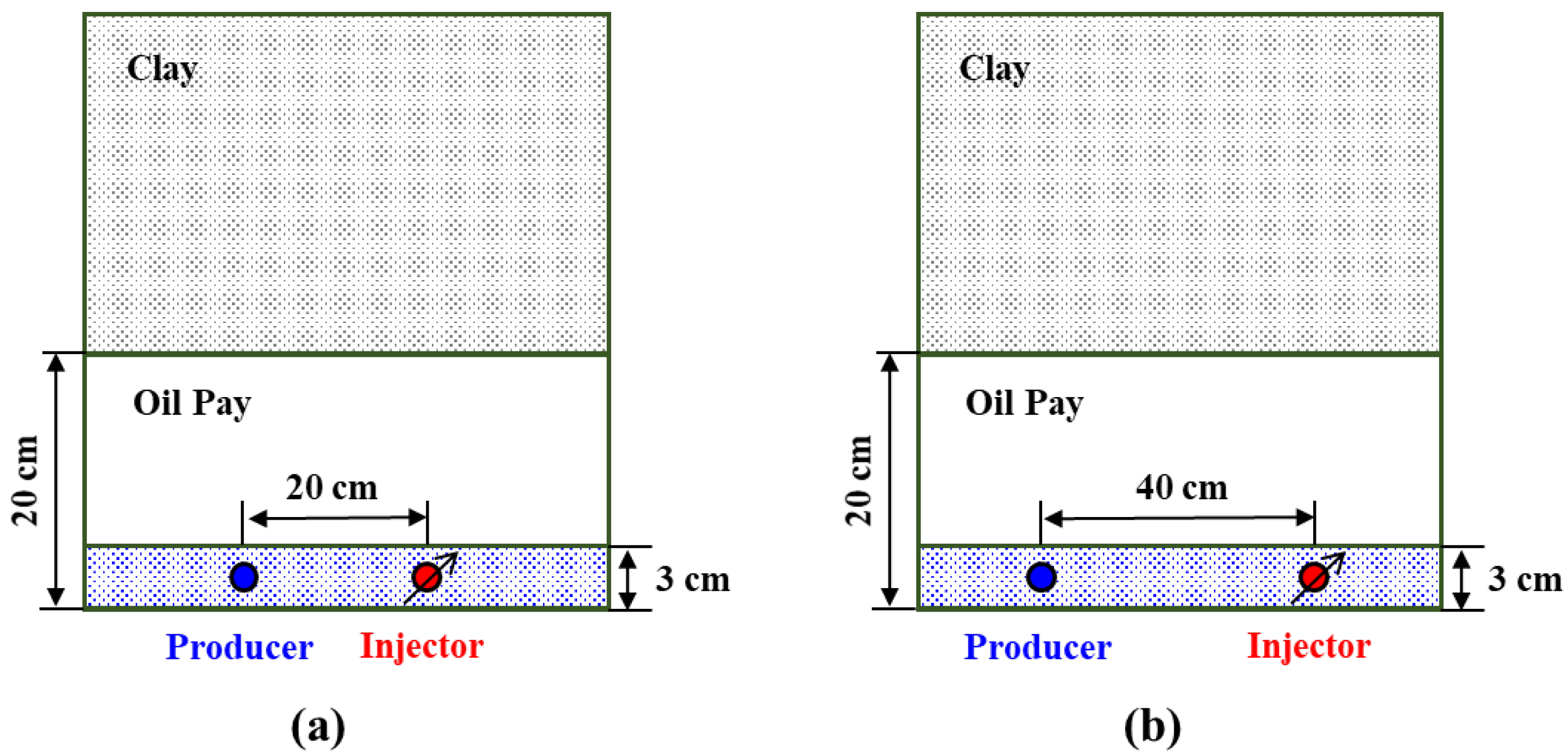
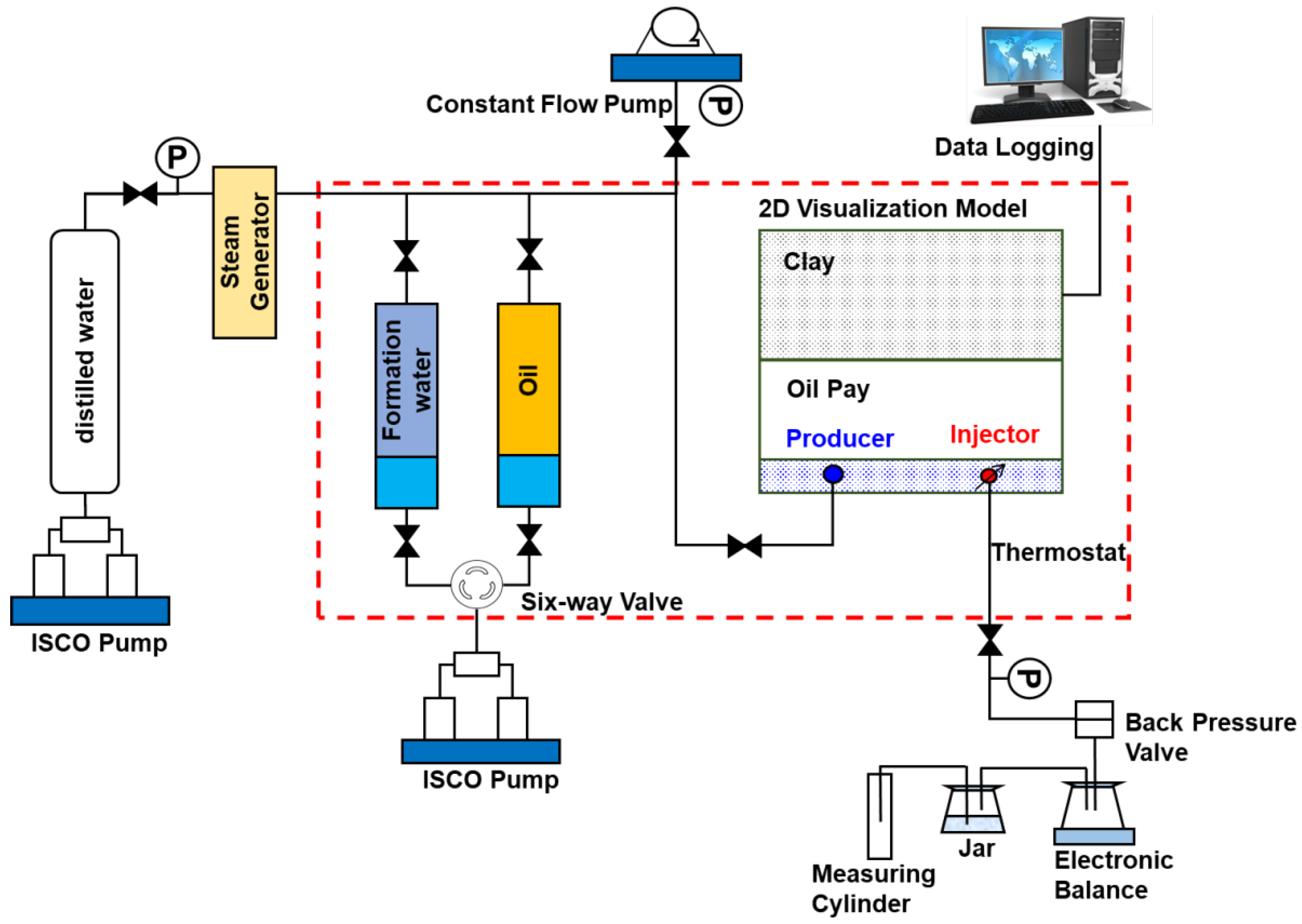

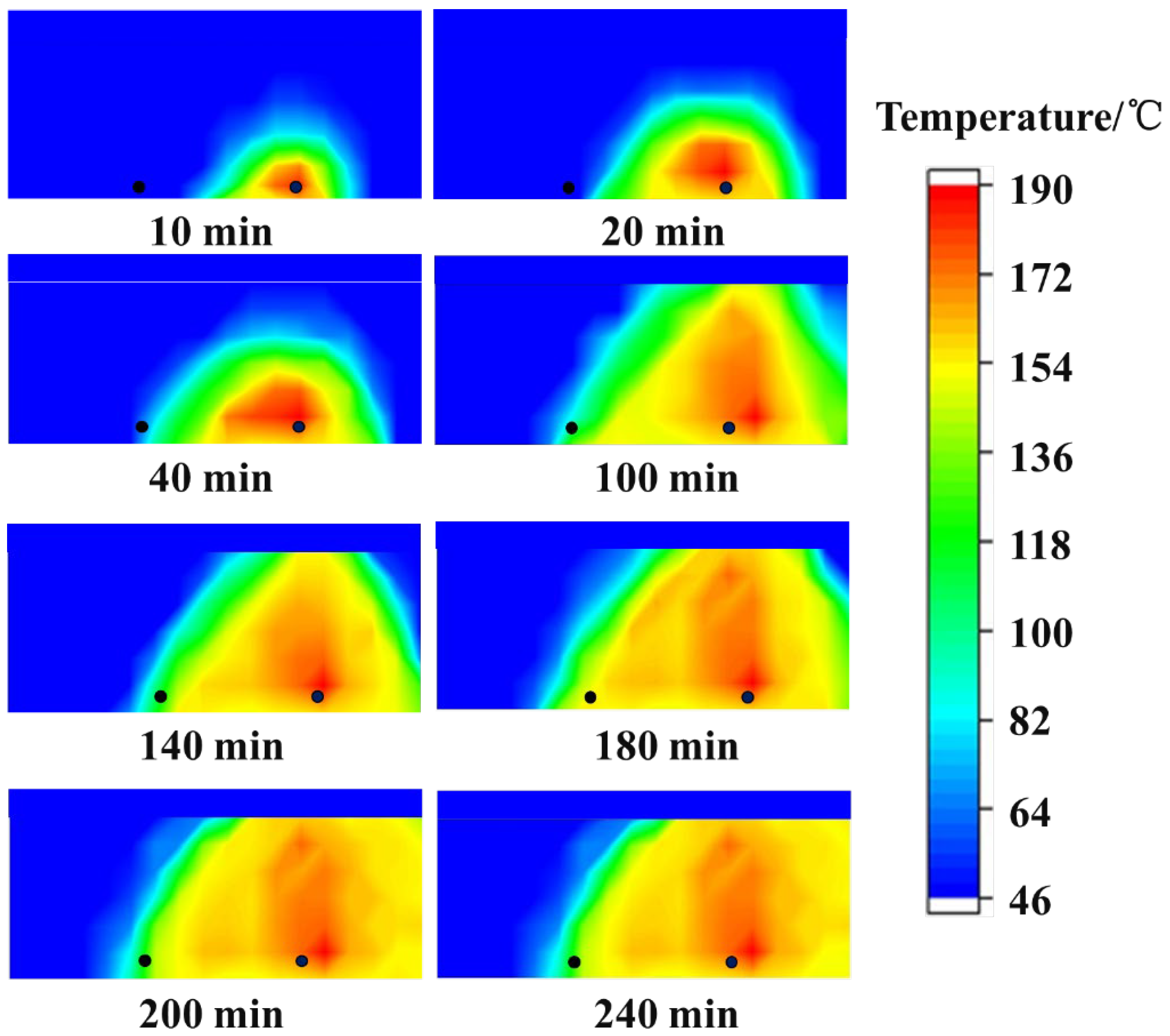
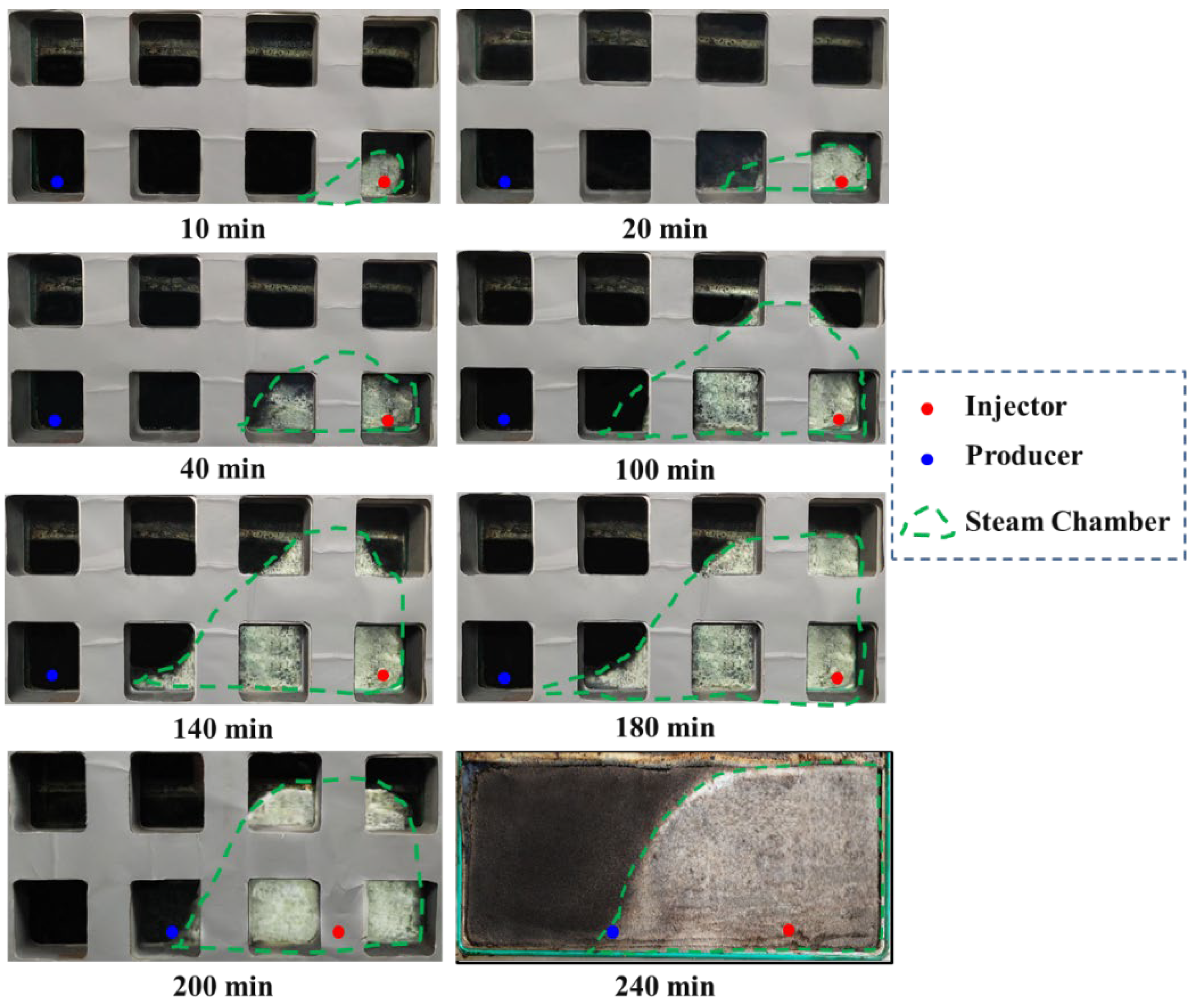

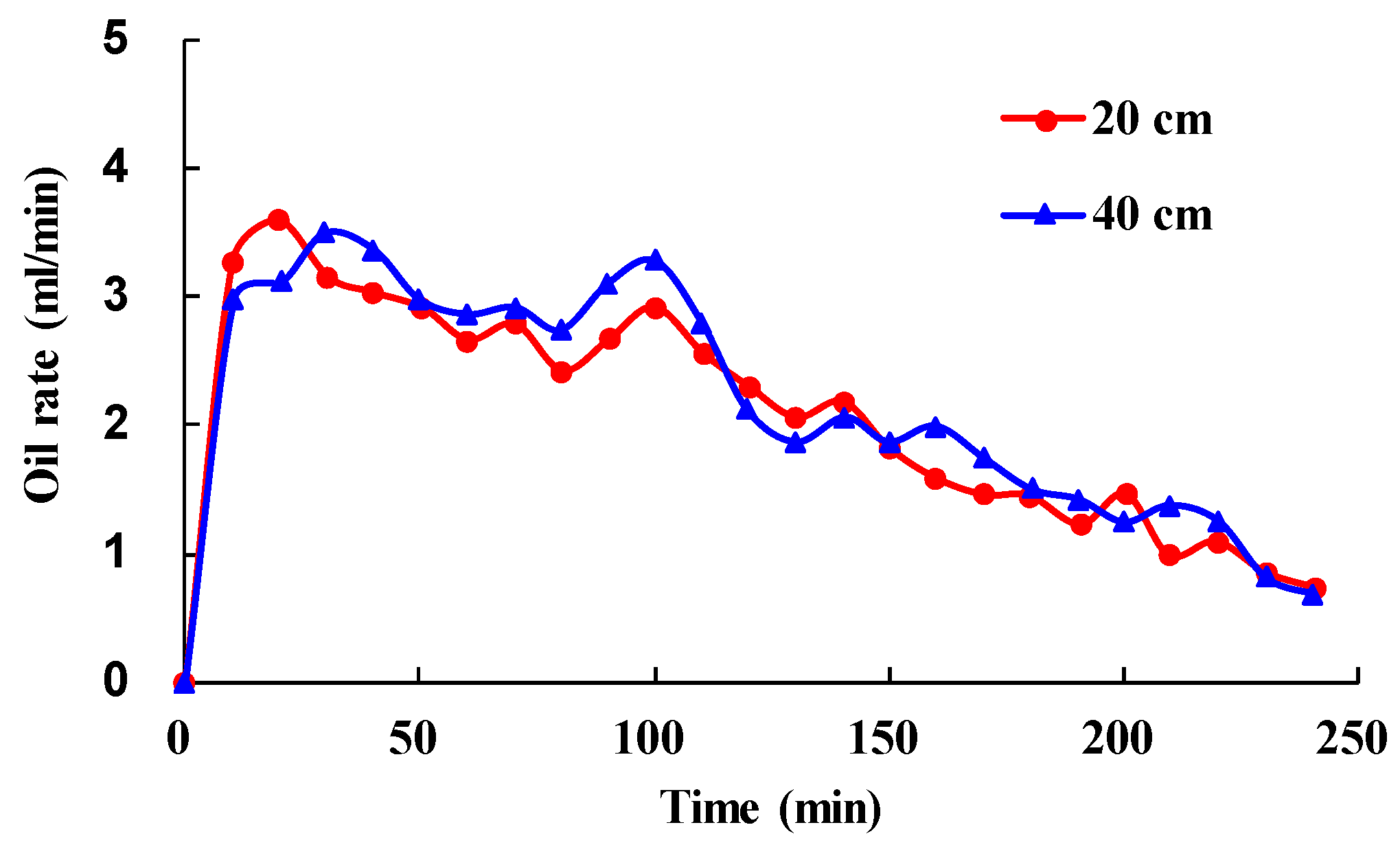

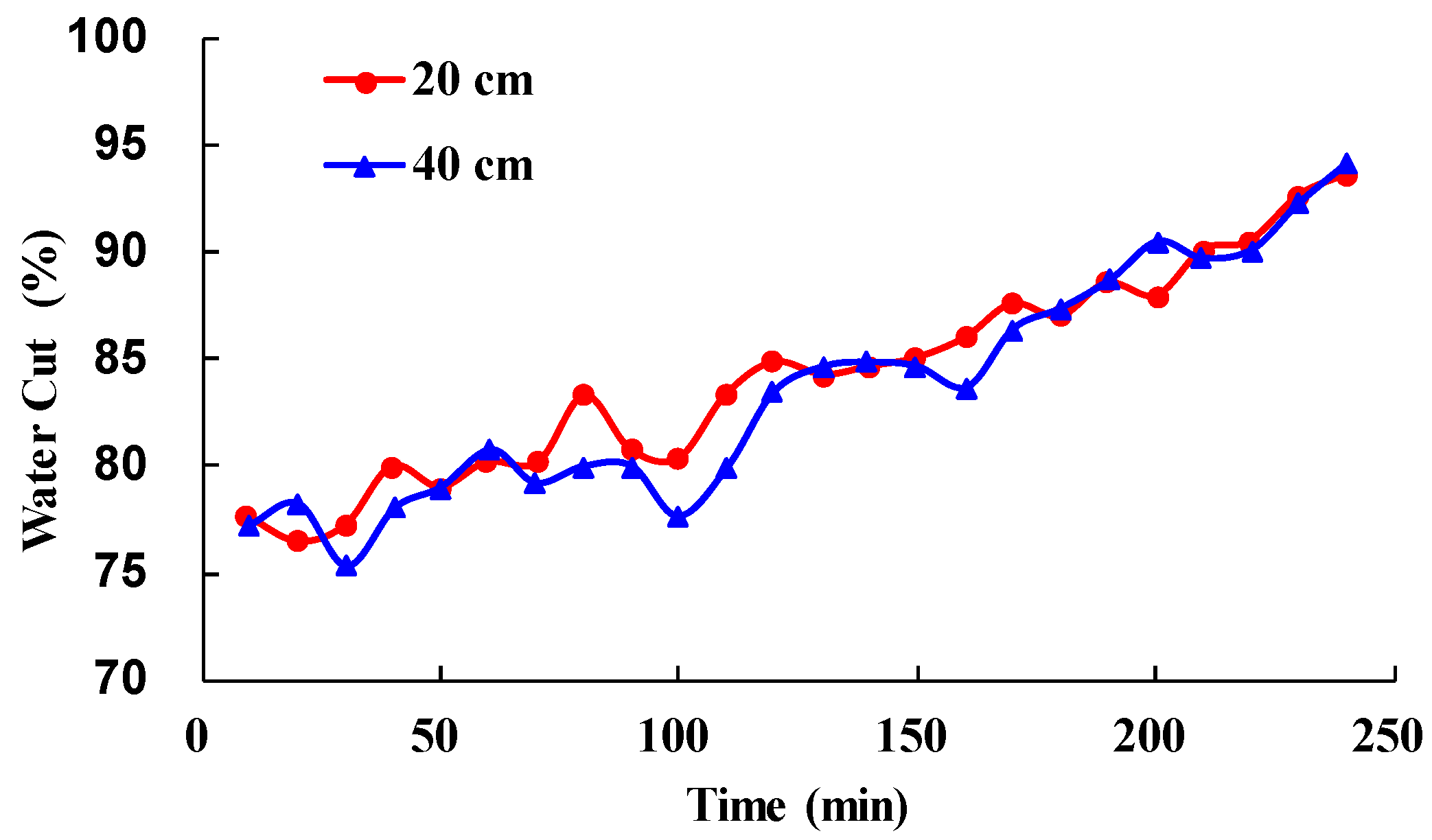
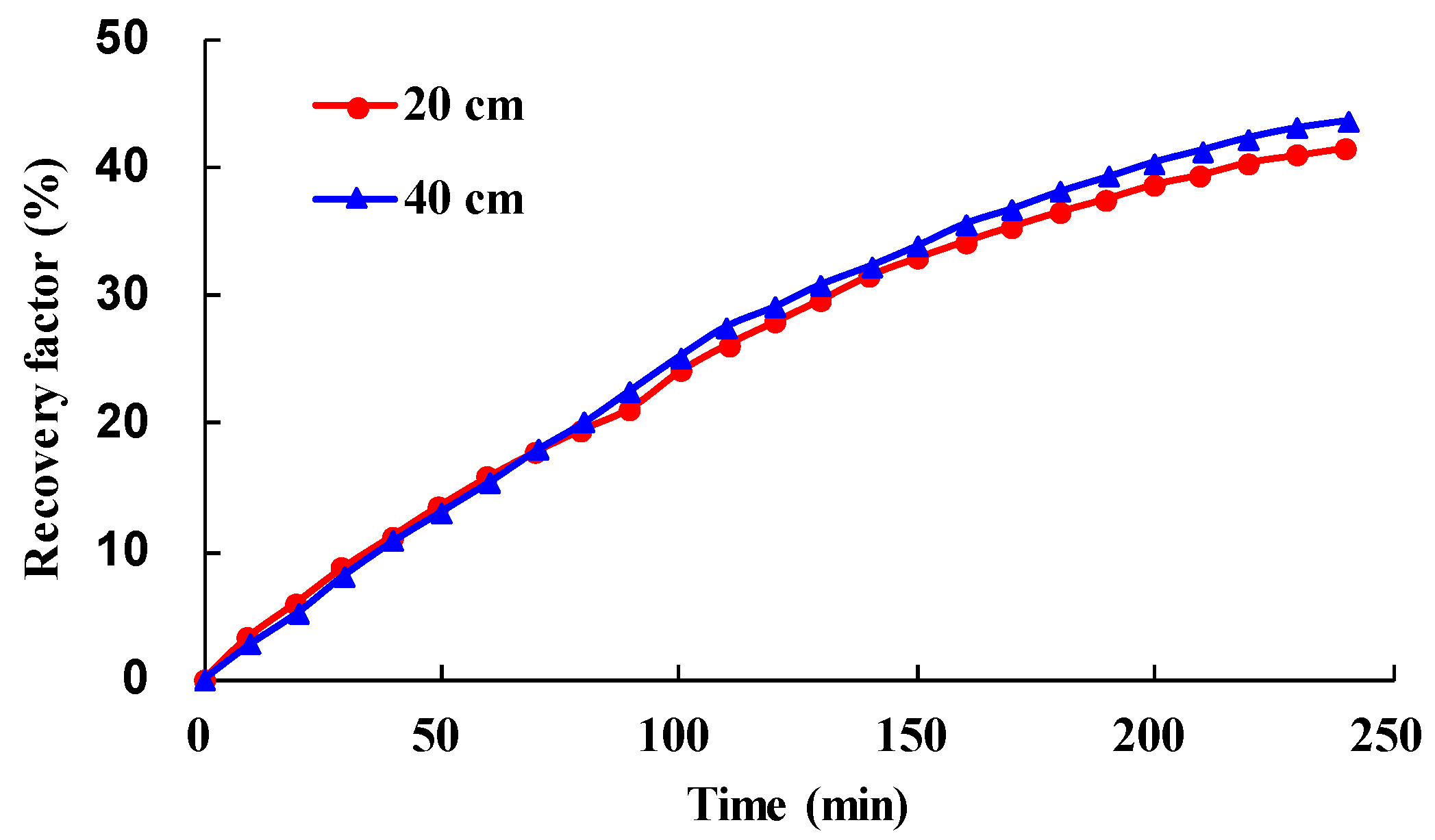
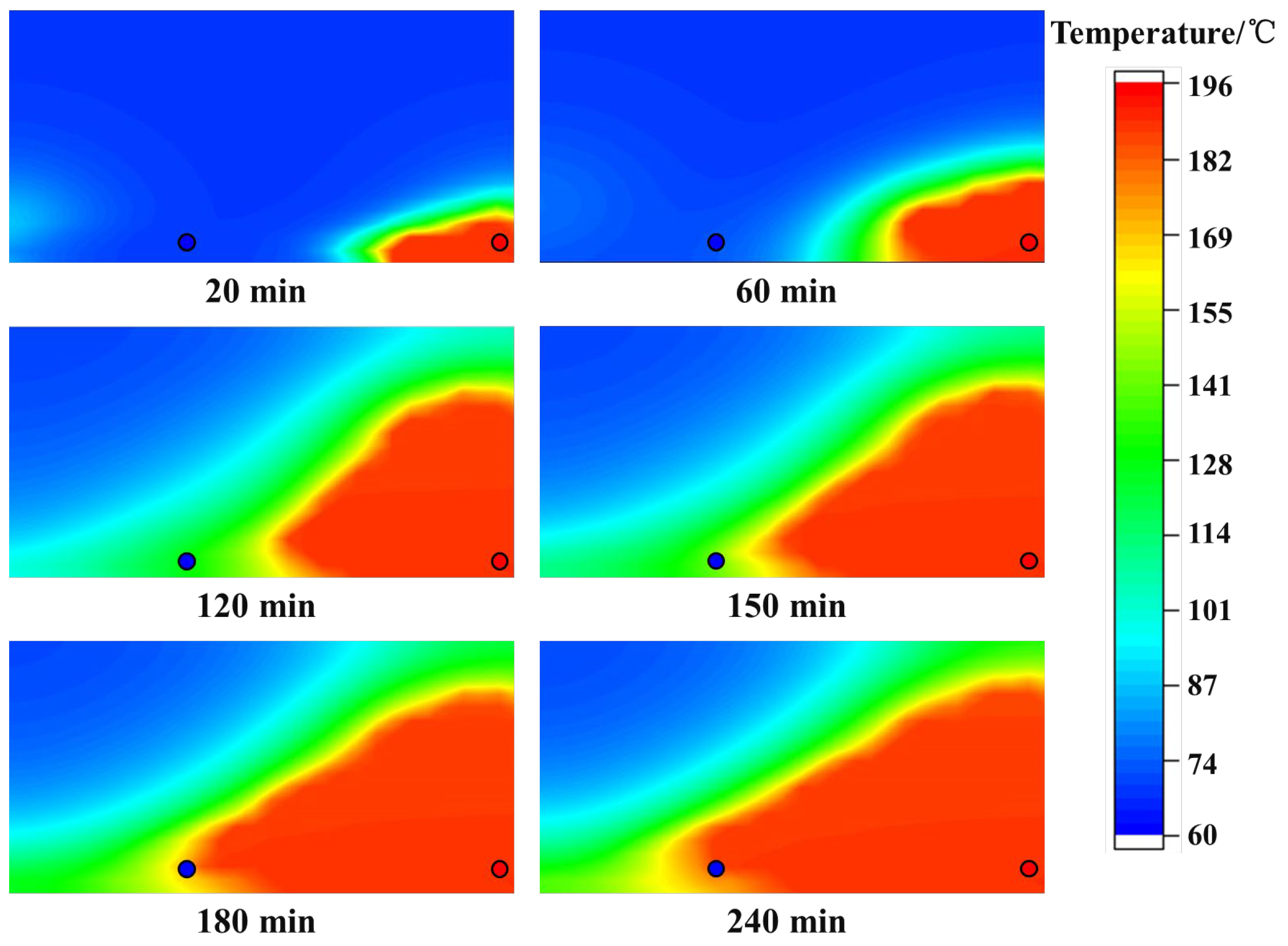
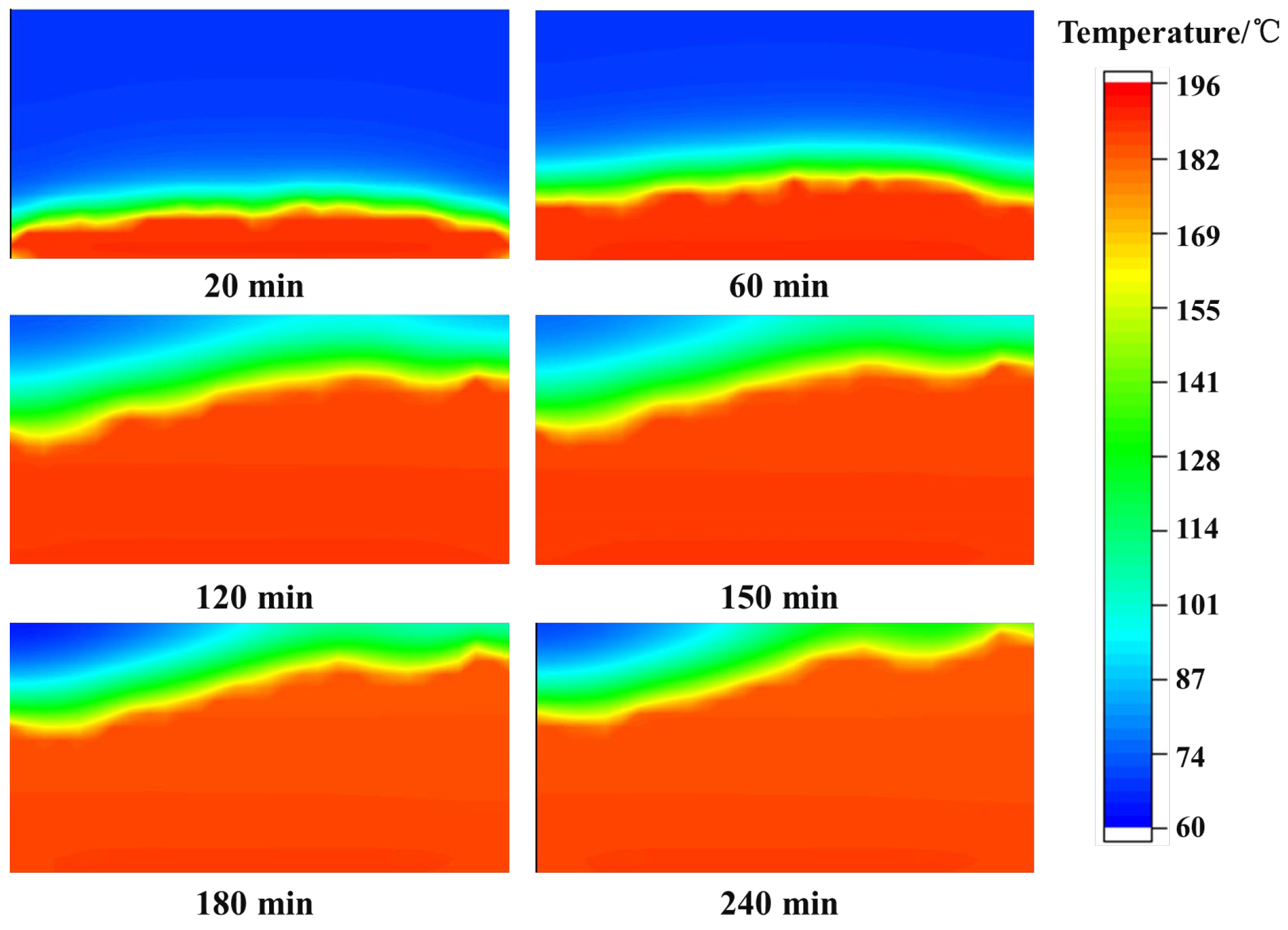


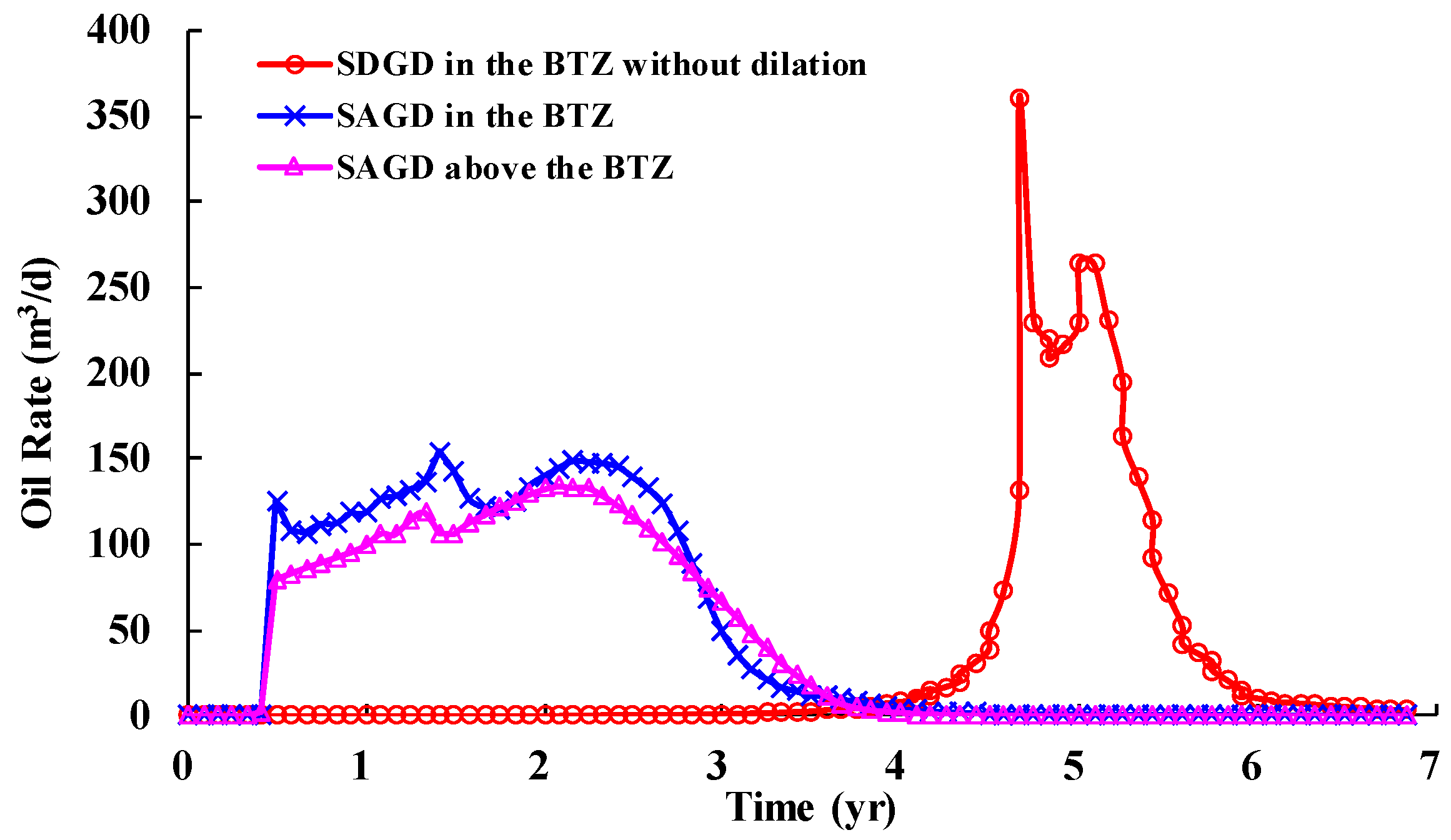
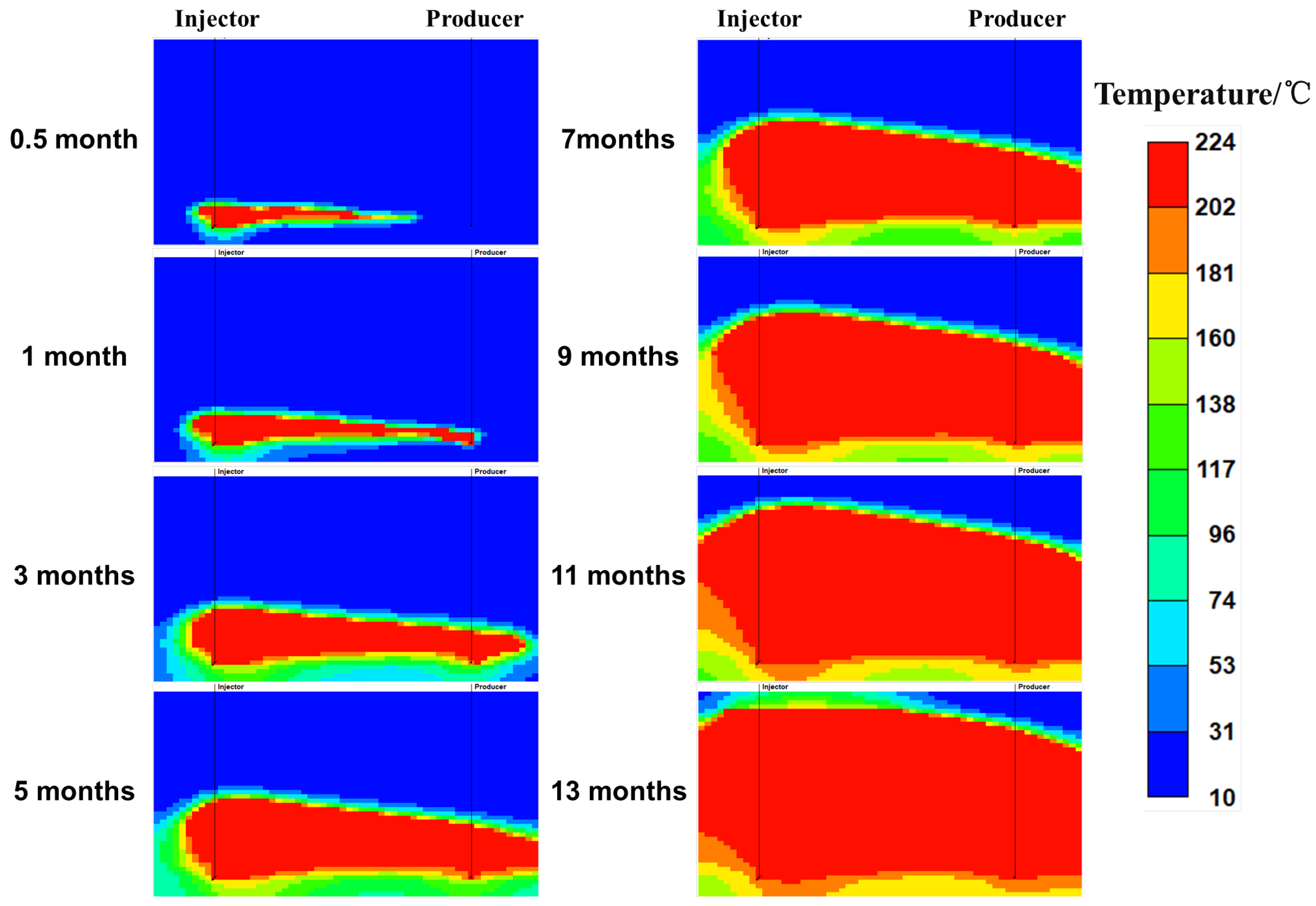
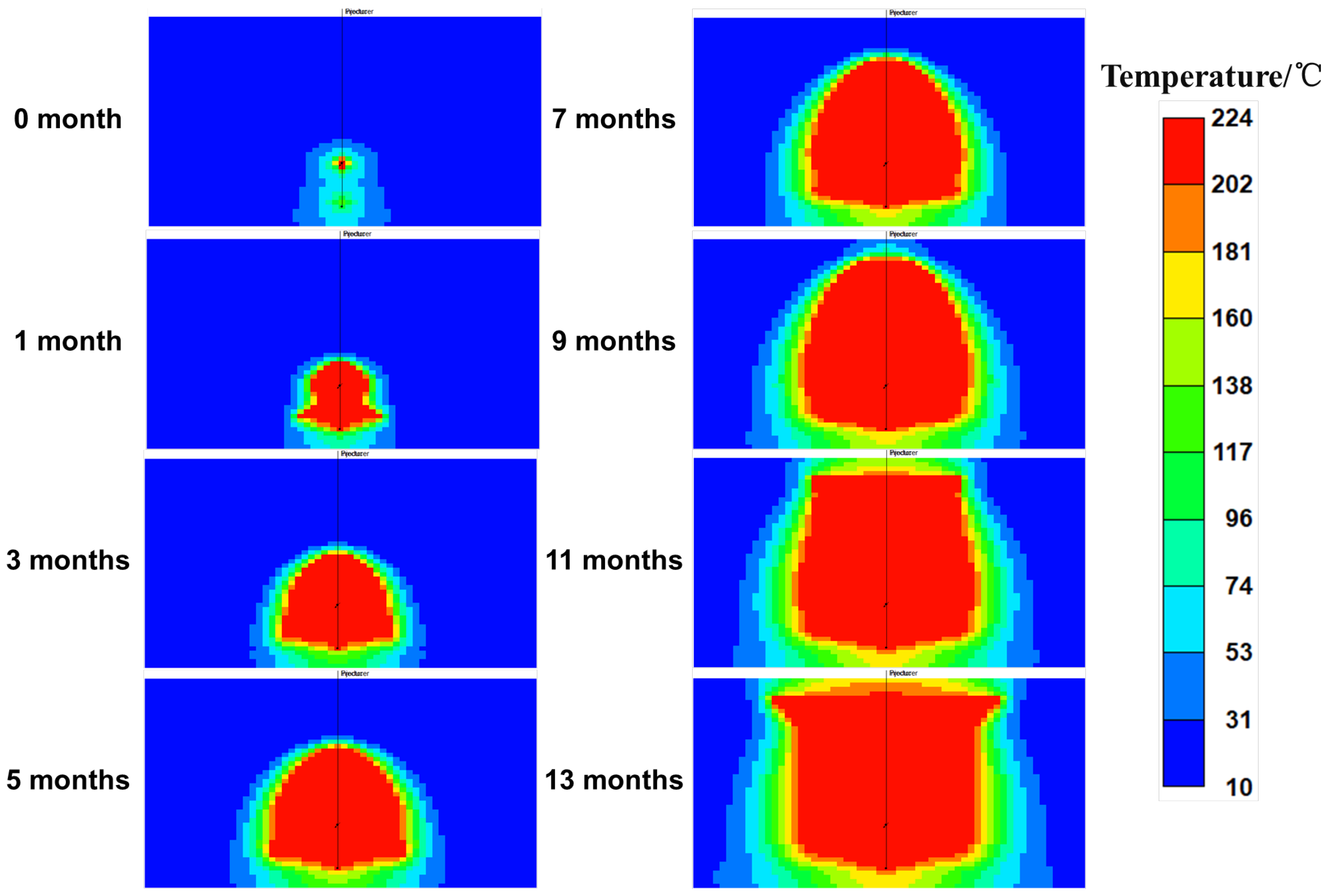
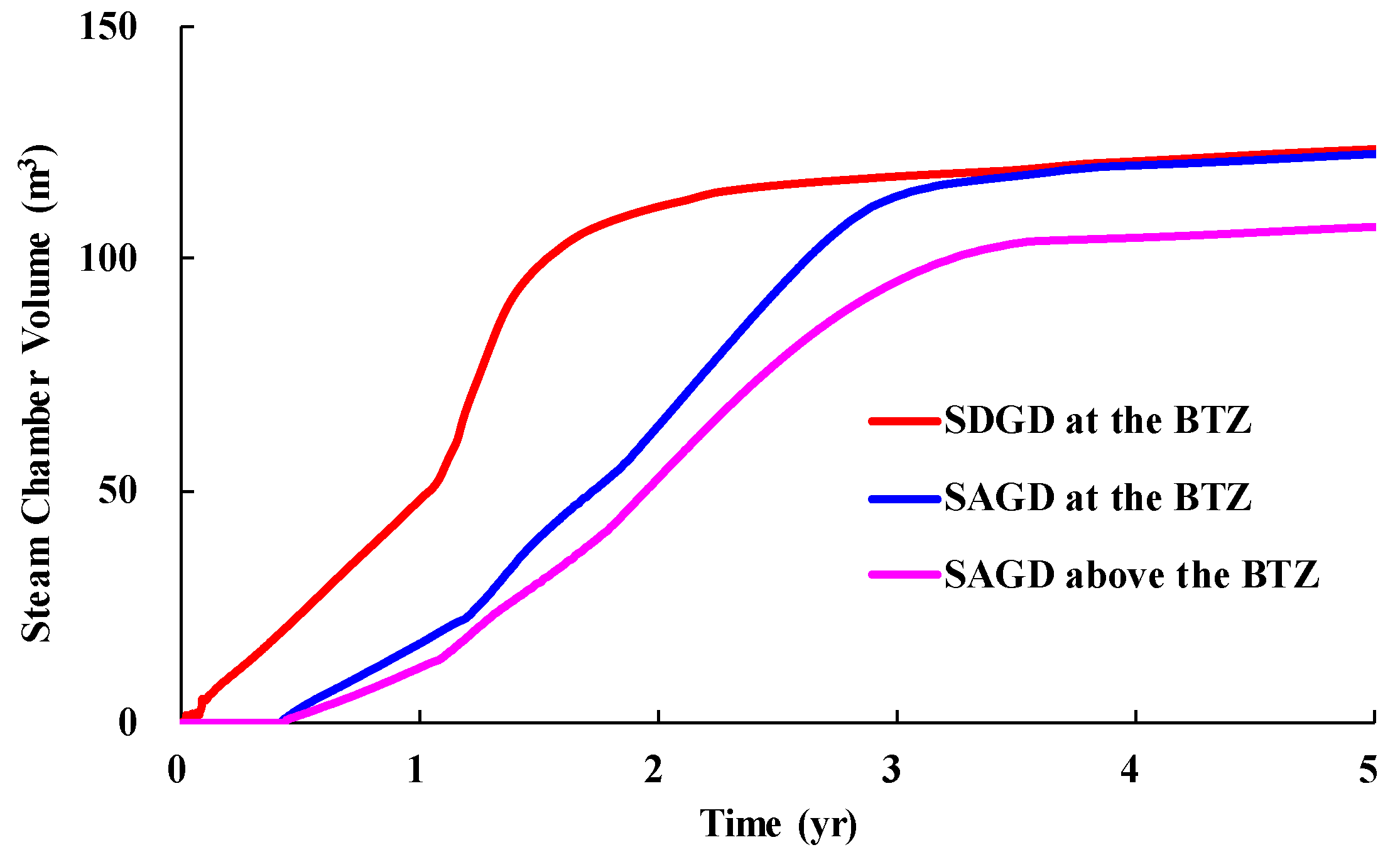
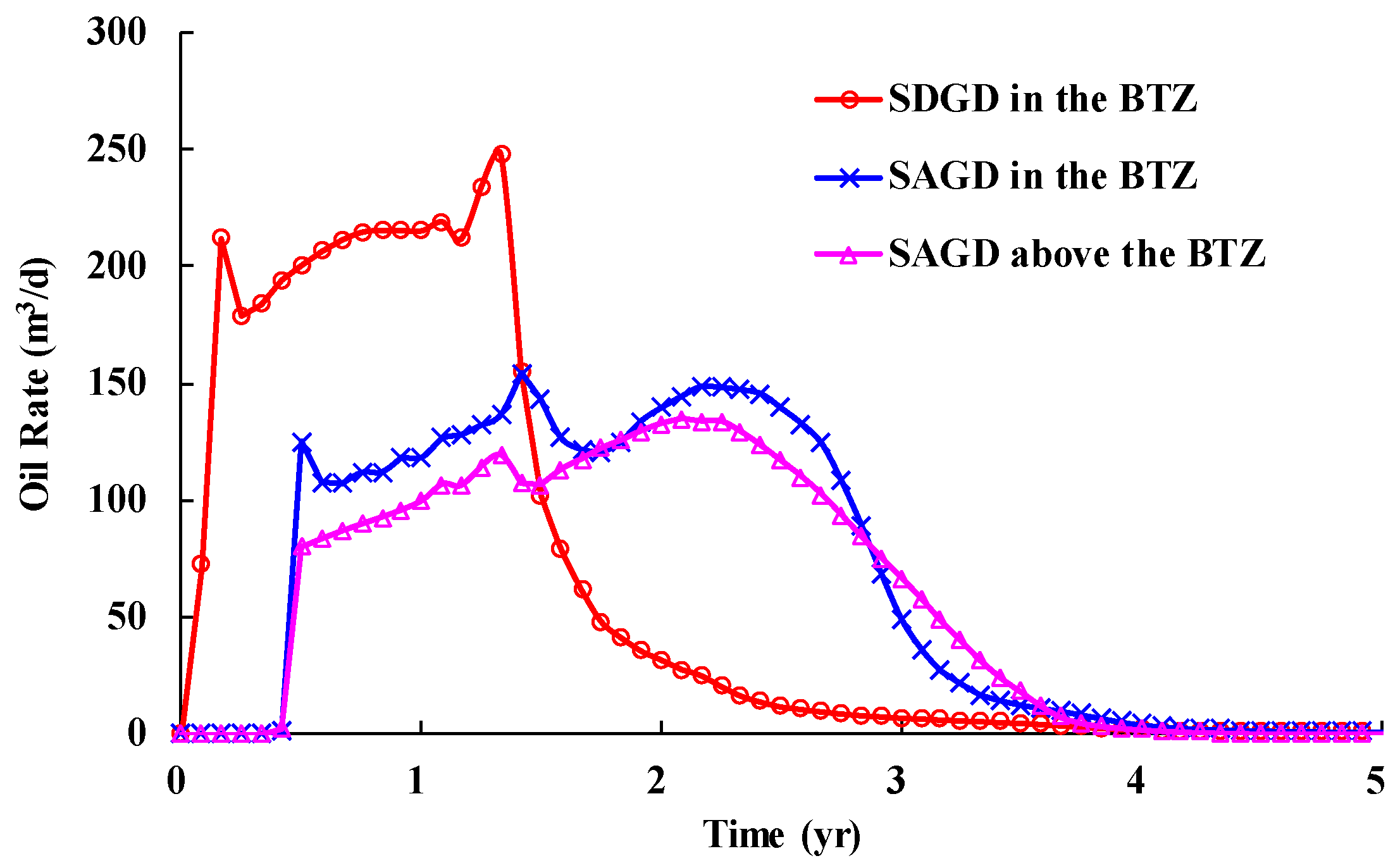


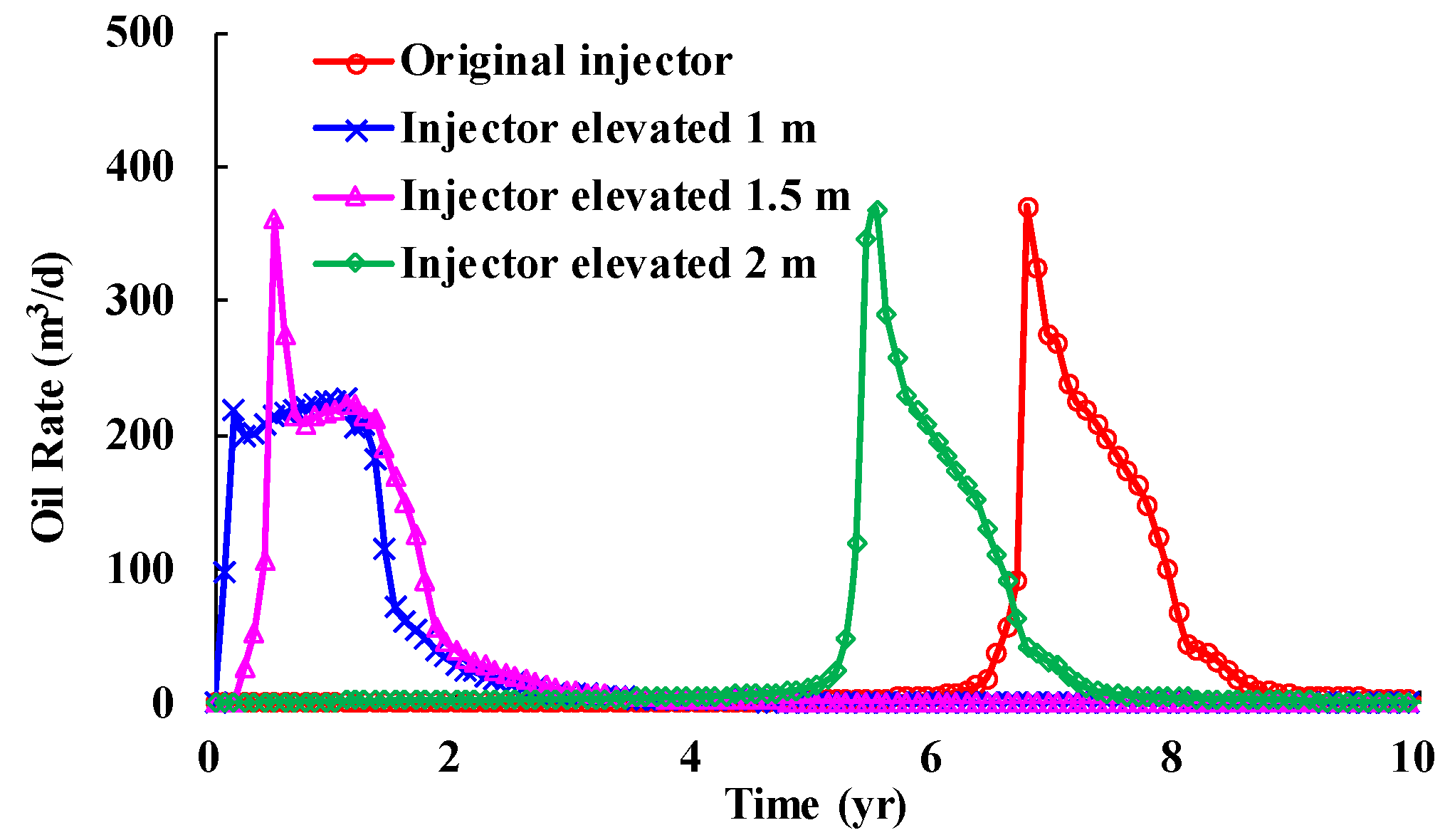

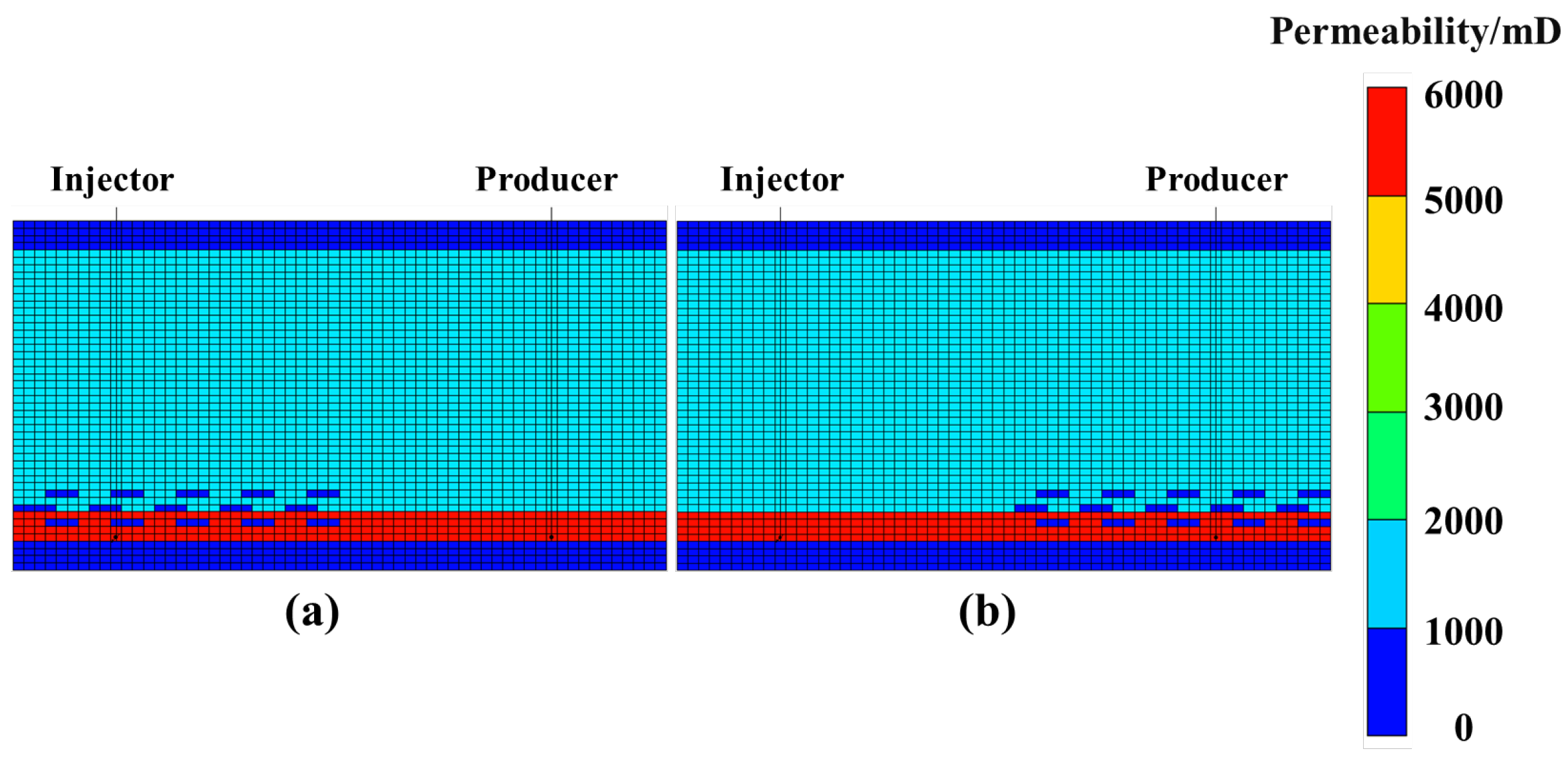
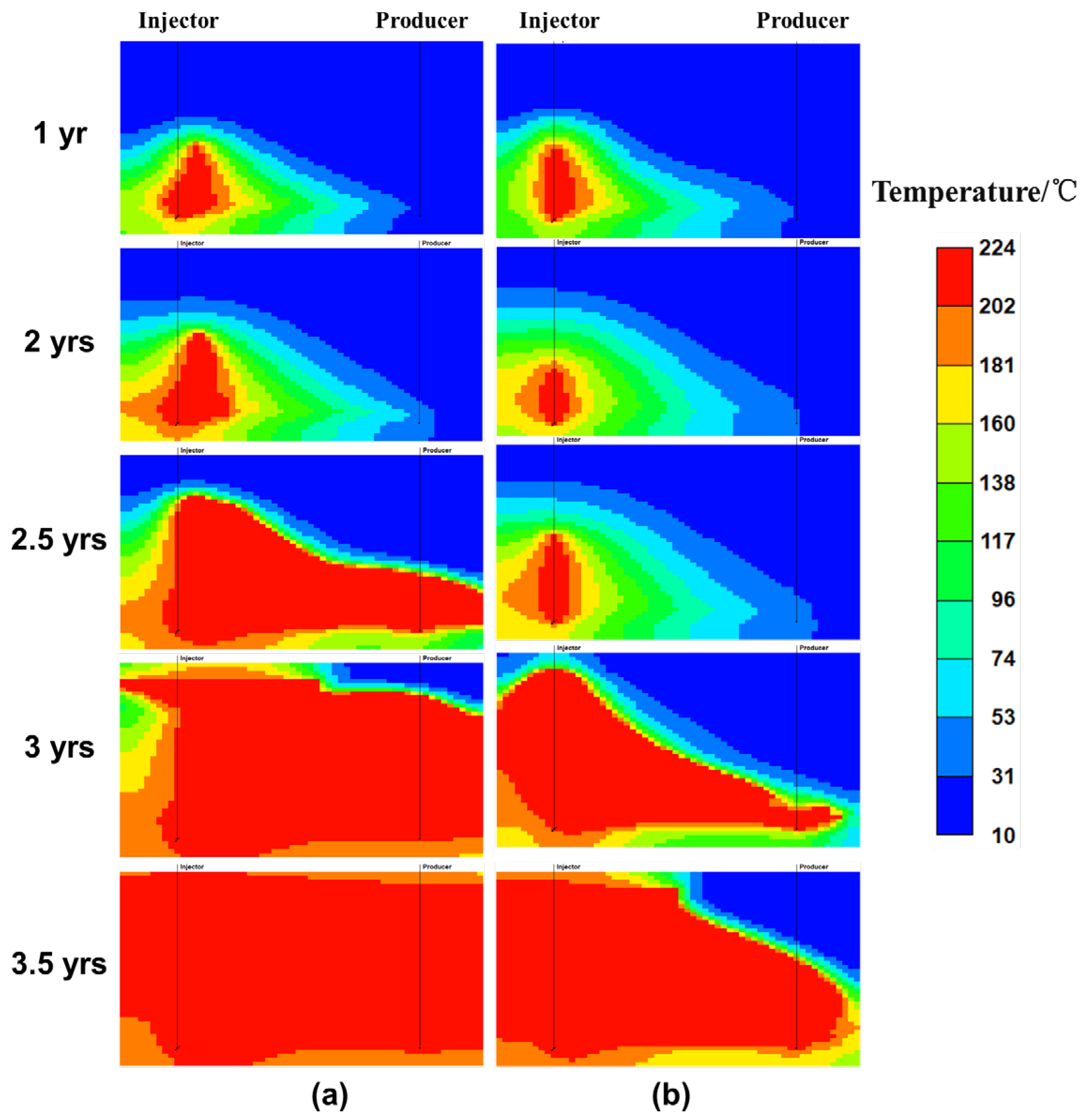

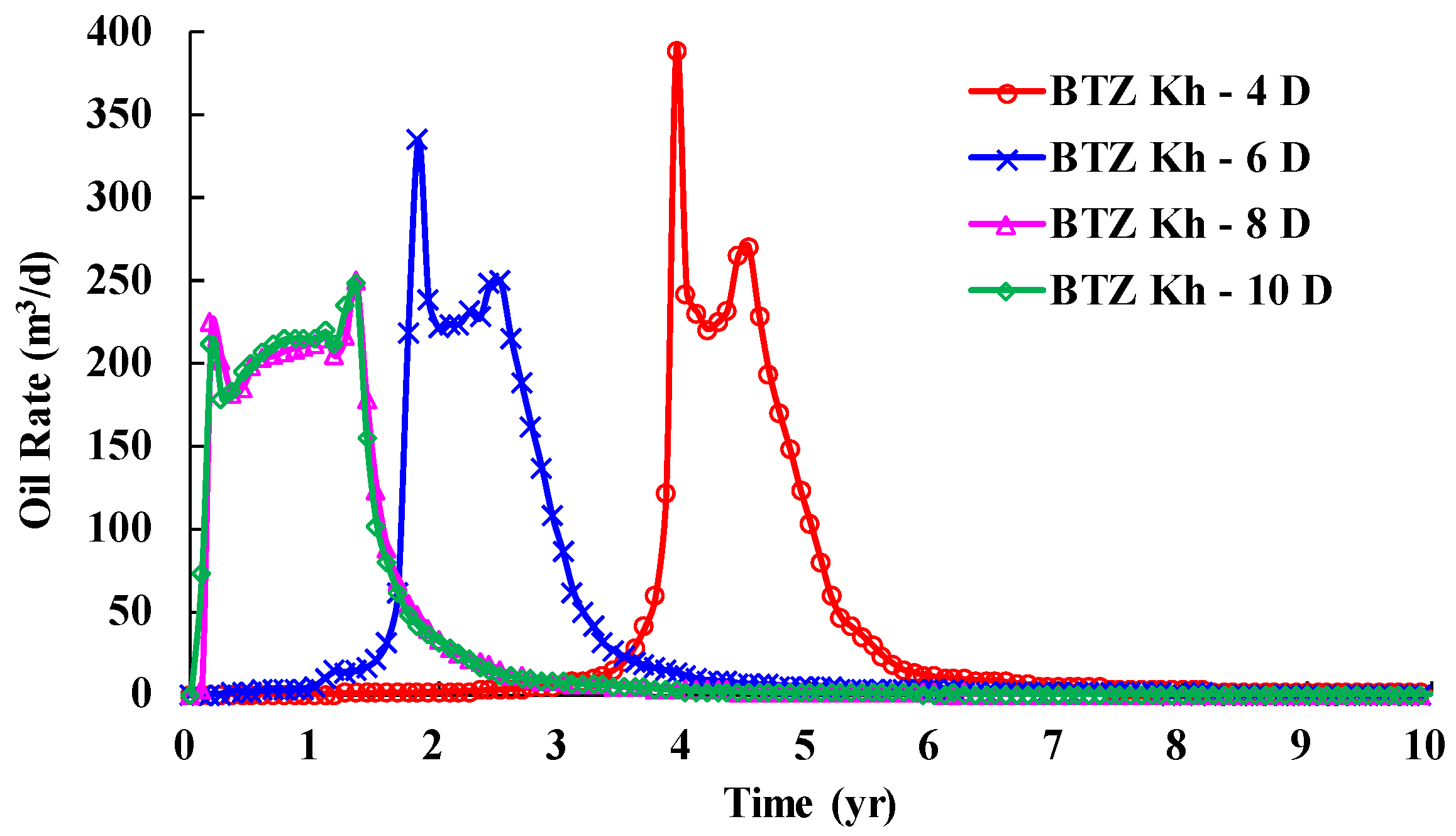

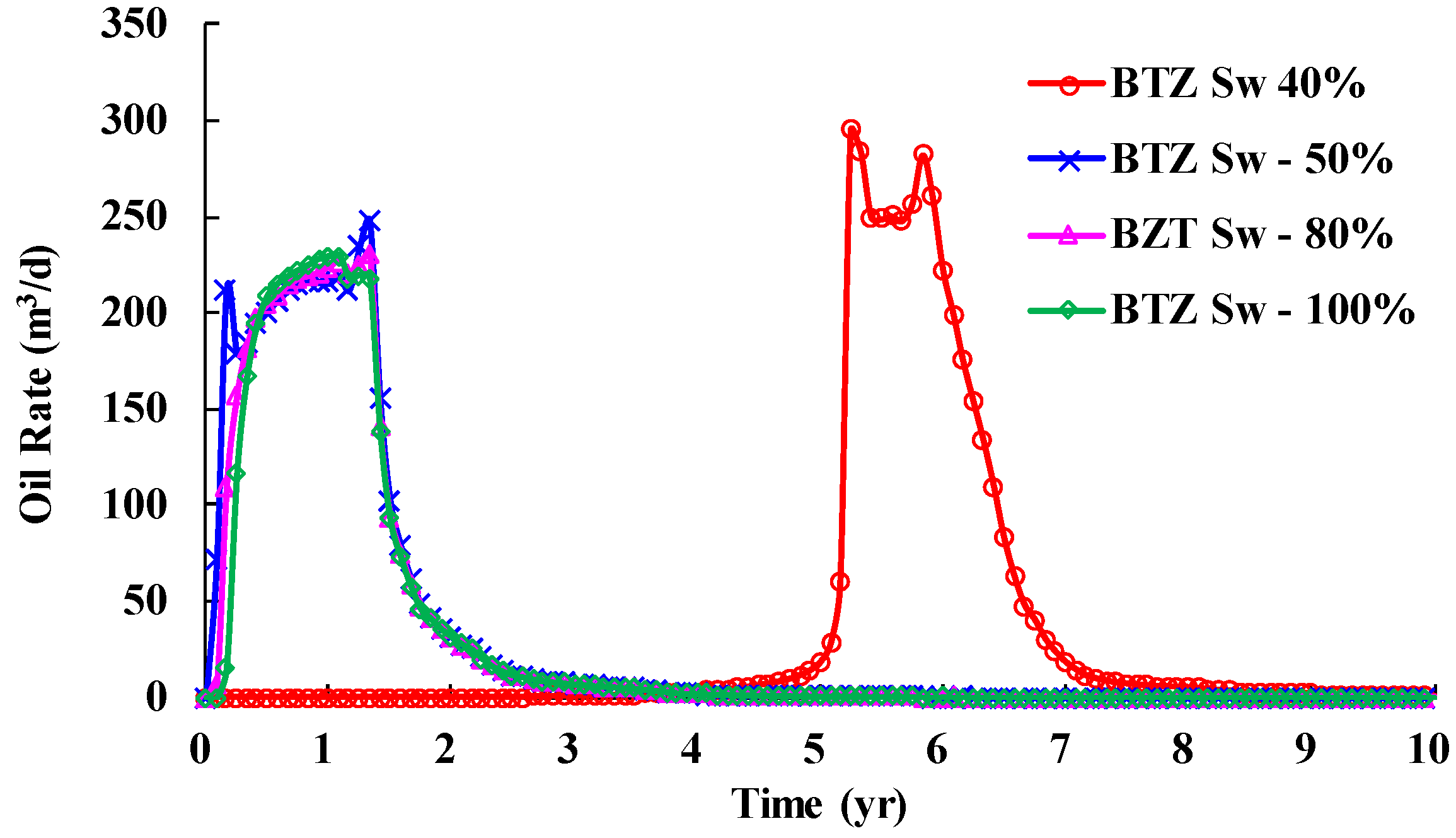
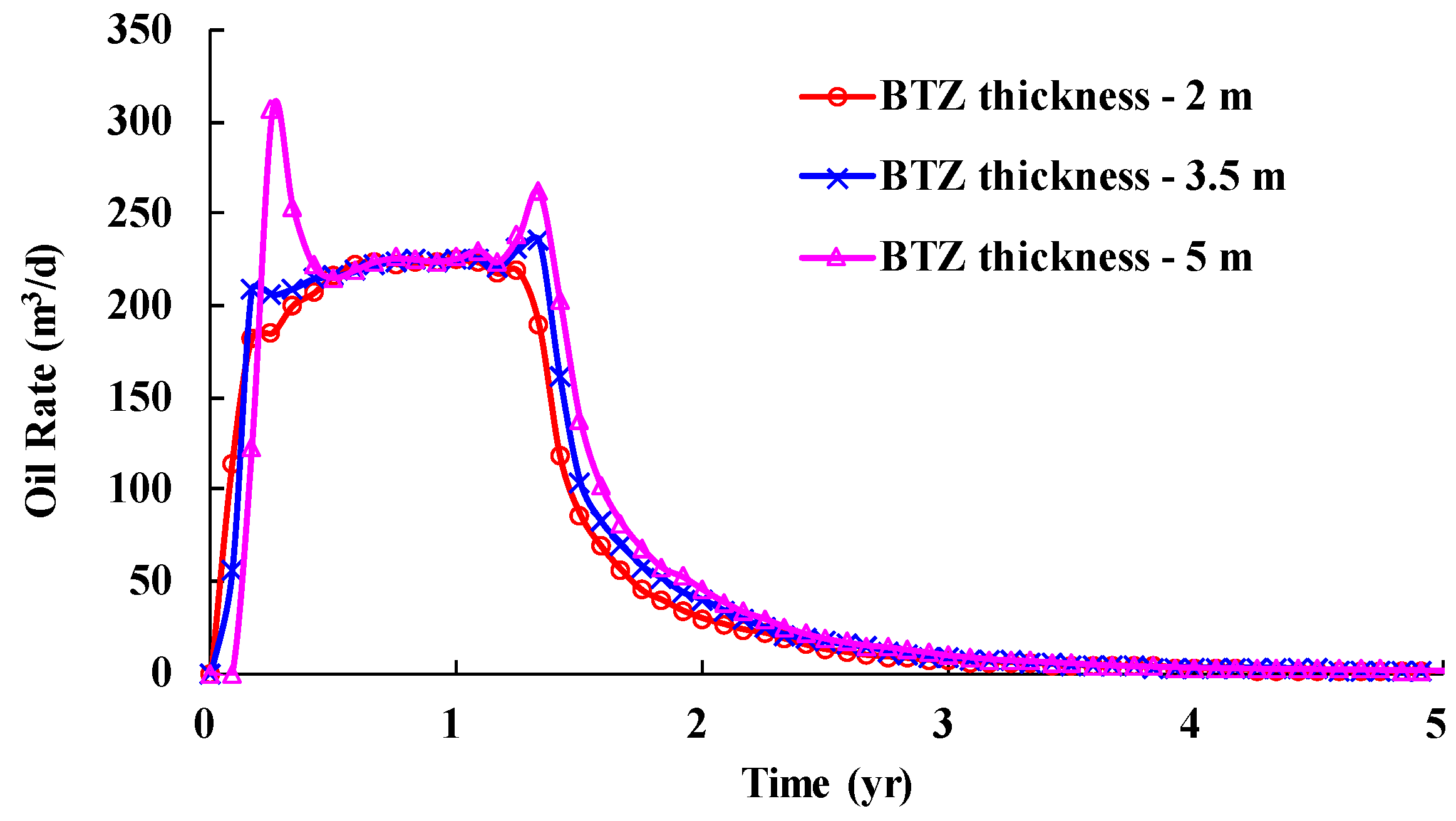
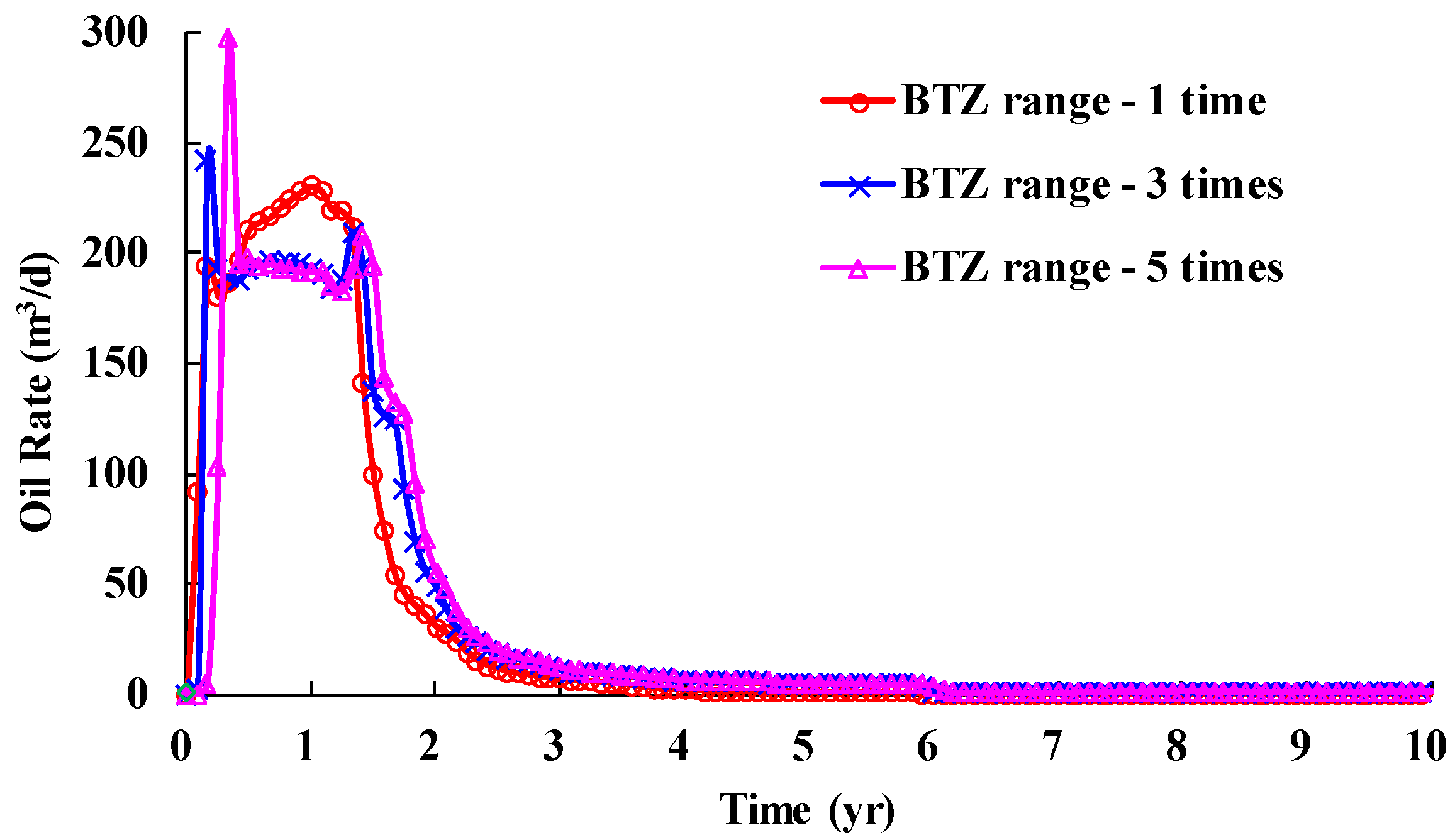
| Parameters | Reservoir | Experiment |
|---|---|---|
| Size/m | 50 × 15 | 0.5 × 0.15 |
| Oil pay thickness/m | 15 | 0.15 |
| Well spacing/m | 20, 40 | 0.2, 0.4 |
| Porosity/% | 33 | 40 |
| Permeability/10−3μm2 | 3252 | 30,020 |
| Oil saturation/% | 74.2 | 80.2 |
| Oil viscosity@50 °C/mPa·s | 15,600 | 980 |
| Oil density@50 °C/kg·m−3 | 1082 | 952 |
| Steam intensity/ t·d−1 | 35 | 10 mL/min |
| Parameters | Reservoir | Experiment |
|---|---|---|
| Size/m | 30 × 30 × 20 | 0.3 × 0.3 × 0.2 |
| Well spacing /m | 40 | 0.4 |
| Porosity/% | 34 | 41 |
| Permeability/10−3μm2 | 2700 | 4217 |
| Oil saturation/% | 80.5 | 80.2 |
| Oil viscosity@50℃/mPa·s | 15,623 | 1180 |
| Oil density@50℃/kg·m−3 | 1032 | 1000 |
| Steam intensity/ t·d−1 | 7 | 20 mL/min |
| Parameters | Value |
|---|---|
| Grid size/m | 1 × 850, 60 × 0.5 m, 48 × 0.5 m |
| Horizontal section length/m | 850 |
| Oil pay thickness/m | 18 |
| Horizontal permeability in the oil pay/D | 3.2 |
| Vertical permeability in the oil pay/D | 1.28 |
| Oil saturation in the oil pay/% | 80 |
| Oil viscosity@10 °C/mPa·s | 5.24 × 106 |
| Water saturation in the BTZ/% | 50 |
| BTZ Thickness/m | 2.0 |
| Horizontal permeability in the BTZ/D | 10.0 |
| Vertical Permeability in the BTZ/D | 6.0 |
| Injection pressure/MPa | 2.5 |
| Subcool/°C | 5 |
Disclaimer/Publisher’s Note: The statements, opinions and data contained in all publications are solely those of the individual author(s) and contributor(s) and not of MDPI and/or the editor(s). MDPI and/or the editor(s) disclaim responsibility for any injury to people or property resulting from any ideas, methods, instructions or products referred to in the content. |
© 2023 by the authors. Licensee MDPI, Basel, Switzerland. This article is an open access article distributed under the terms and conditions of the Creative Commons Attribution (CC BY) license (https://creativecommons.org/licenses/by/4.0/).
Share and Cite
Xie, Q.; Liang, G.; Liu, S.; Wang, R.; Feng, M.; Liao, C. Physical and Numerical Simulations of Steam Drive and Gravity Drainage Using the Confined Bottom Oil–Water Transition Zone to Develop Super Heavy Oil. Energies 2023, 16, 6302. https://doi.org/10.3390/en16176302
Xie Q, Liang G, Liu S, Wang R, Feng M, Liao C. Physical and Numerical Simulations of Steam Drive and Gravity Drainage Using the Confined Bottom Oil–Water Transition Zone to Develop Super Heavy Oil. Energies. 2023; 16(17):6302. https://doi.org/10.3390/en16176302
Chicago/Turabian StyleXie, Qian, Guangyue Liang, Shangqi Liu, Ruifeng Wang, Min Feng, and Changlin Liao. 2023. "Physical and Numerical Simulations of Steam Drive and Gravity Drainage Using the Confined Bottom Oil–Water Transition Zone to Develop Super Heavy Oil" Energies 16, no. 17: 6302. https://doi.org/10.3390/en16176302





